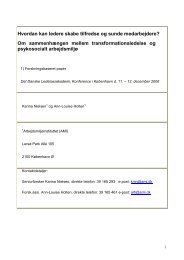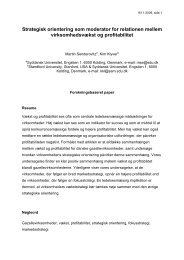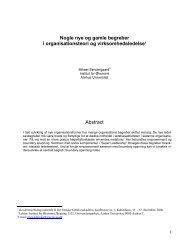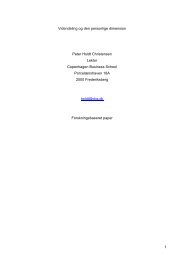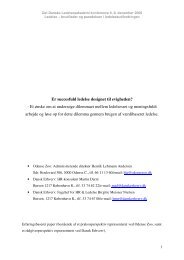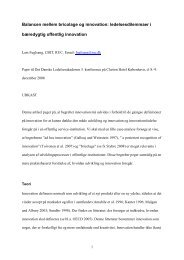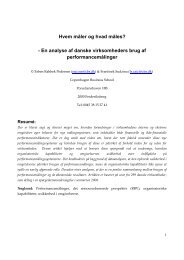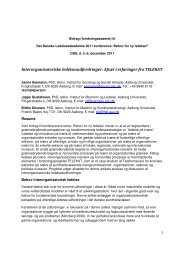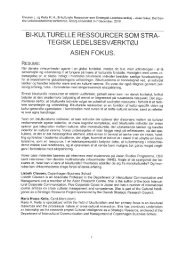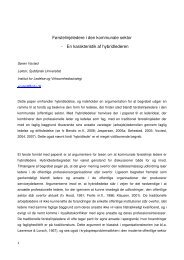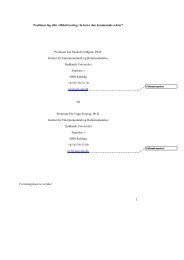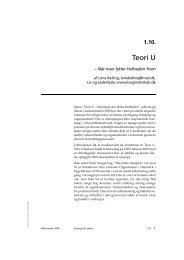Change management in public reforms - Det Danske ...
Change management in public reforms - Det Danske ...
Change management in public reforms - Det Danske ...
Create successful ePaper yourself
Turn your PDF publications into a flip-book with our unique Google optimized e-Paper software.
Paper for the Danish Academy of Management conference titled ’A New Agenda for Management’,Copenhagen, 11-12 December 2006<strong>Change</strong> <strong>management</strong> <strong>in</strong> <strong>public</strong> <strong>reforms</strong>- lessons from the Danish police reformResearch paperRex DegnegaardPhD Fellow, Dept. of Management, Politics & PhilosophyCopenhagen Bus<strong>in</strong>ess SchoolPorcelaenshaven 18ADK – 2000 Frederiksbergrex@cbs.dk
<strong>Change</strong> Management <strong>in</strong> Public Reforms 2006change <strong>management</strong> models could be seen as resistance to change models at large or assimple excuses stemm<strong>in</strong>g from the ‘not <strong>in</strong>vented here syndrome’ or for simply avoid<strong>in</strong>g thedifficult reflections and decisions which change <strong>management</strong> tends to impose onmanagers. Rather than see<strong>in</strong>g the criticism as global truths and thereby reject<strong>in</strong>g the valueof change <strong>management</strong> as a <strong>management</strong> discipl<strong>in</strong>e for the <strong>public</strong> sector or simplyrefus<strong>in</strong>g the criticism, this paper <strong>in</strong>quires <strong>in</strong>to the content of the criticism <strong>in</strong> regards to<strong>public</strong> <strong>management</strong> reform by ask<strong>in</strong>g; what are the implications of the differences betweenchange <strong>management</strong> <strong>in</strong> <strong>public</strong> and private organizations – and what are their implicationsfor <strong>public</strong> <strong>management</strong> reform.The paper concludes that traditional perceptions <strong>in</strong> theory as well as <strong>in</strong> practice of theroles of managers and employees may lead to stigmatization. By shift<strong>in</strong>g theseperceptions the roles of managers and employees may be clarified and even broadenedthereby <strong>in</strong>vit<strong>in</strong>g reflection <strong>in</strong>to the role of the other and <strong>in</strong>to one’s own role. Thisbroaden<strong>in</strong>g may <strong>in</strong> turn lead to erosion of the stigmatization of managers and employees.The aim of this paper is to add to the development of research based perspectives and<strong>in</strong>sights <strong>in</strong>to <strong>public</strong> <strong>management</strong> reform based on lessons from the Danish police reform.The paper shows how change <strong>management</strong> models can be used <strong>in</strong> <strong>public</strong> sector <strong>reforms</strong>to help overcome <strong>management</strong> challenges that emerge from the reorganization. Illustratedby the case of the Danish police reform, it is shown how change <strong>management</strong> models canp<strong>in</strong>po<strong>in</strong>t relevant <strong>management</strong> challenges which are often neglected. Descriptions ofpractice <strong>in</strong> the police force are based on participant observation field studies <strong>in</strong> theNational police and <strong>in</strong> local police districts.This paper is part of a three year PhD project which was <strong>in</strong>itiated early this year. Thus it iswork <strong>in</strong> progress which will be supported by a strengthened theoretical foundation and byfurther empirical studies to provide a larger base of lessons from the police reform.Rex Degnegaard Page 3 of 14
<strong>Change</strong> Management <strong>in</strong> Public Reforms 2006In the job function as police officer where one’s one safety potentially is at stake to a greatextent, social capital is not only an outcome of the function but also a precondition. This isstressed by Sennett <strong>in</strong> reference to military organizations:Loyalty is a prime test of this version of social capital. Military organizations havehigh social capital, ev<strong>in</strong>ced when people are will<strong>in</strong>g to sacrifice their lives out ofloyalty to the <strong>in</strong>stitution or to the network of solders with<strong>in</strong> an army. (Sennett, 2005, p.64)The example of the military organization, which <strong>in</strong> many aspects is parallel to the police,gives a clear picture of why social capital is necessary <strong>in</strong> <strong>public</strong> organizations. Even whentransferred to other <strong>public</strong> organizations <strong>in</strong> which the safety aspects are not of relevance,the importance of social capital is evident. Though lack<strong>in</strong>g the potentially dramaticconsequences as for military and police organizations, absence of loyalty and trust <strong>in</strong> other<strong>public</strong> organizations may result <strong>in</strong> undesirable consequences result<strong>in</strong>g unpredictabledecisions by adm<strong>in</strong>istration. Thus, these characteristics illustrate dynamics of the logicbeh<strong>in</strong>d <strong>public</strong> organizations which provide specific challenges to <strong>public</strong> <strong>management</strong> – andto <strong>public</strong> <strong>management</strong> reform. Essential for <strong>management</strong> <strong>in</strong> daily operations as well as <strong>in</strong>and serve as specific challenges to <strong>public</strong> <strong>management</strong> reform.In conclusion to this <strong>in</strong>quiry <strong>in</strong>to challenges of <strong>public</strong> <strong>management</strong> reform, it appears thatthe primary premise for <strong>public</strong> function to be managed rests upon stability which is aprecondition for susta<strong>in</strong><strong>in</strong>g and enhanc<strong>in</strong>g democratic awareness and function. To ensurethis predictability, a central <strong>management</strong> challenge is to foster organizational and<strong>in</strong>dividual stability for which trust and loyalty are essential.When conclud<strong>in</strong>g that the essential premise of <strong>management</strong> challenge to <strong>public</strong><strong>management</strong> <strong>reforms</strong> is democratic awareness and function, it is not to neglect theimportance of efficiency and economic orientation. In the case of the Danish police reform,the organization is better off regard<strong>in</strong>g economic stra<strong>in</strong> than for example other Danish<strong>reforms</strong> and other police <strong>reforms</strong> such as the Norwegian reform. The differentorganizational orientations are <strong>in</strong>terconnected as described by Pollitt and Bouckaert <strong>in</strong>their views of <strong>in</strong> <strong>public</strong> <strong>management</strong> reform <strong>in</strong> their comparative studies of <strong>reforms</strong> acrosscountries throughout the world:Rex Degnegaard Page 8 of 14
<strong>Change</strong> Management <strong>in</strong> Public Reforms 2006Public <strong>management</strong> reform is usually thought of as a means to an end, not an end <strong>in</strong>itself. To be more precise we should perhaps say that it is potentially a means tomultiply ends. These <strong>in</strong>clude mak<strong>in</strong>g sav<strong>in</strong>gs (economies) <strong>in</strong> <strong>public</strong> expenditure,improv<strong>in</strong>g the quality of <strong>public</strong> services, mak<strong>in</strong>g the operations of government moreefficient, and <strong>in</strong>creas<strong>in</strong>g the chances that the policies which are chosen andimplemented will be effective. (Pollitt & Bouckaert, 2004, p. 6)Thus there are many demands set forward to managers <strong>in</strong> <strong>public</strong> <strong>management</strong> which isalso seen <strong>in</strong> the case of the police reform which entails all of the above. Demands whichare parallel to the demands of reorganization <strong>in</strong> private sector organization. Sav<strong>in</strong>gs,quality, efficiency, and effectiveness are all overlapp<strong>in</strong>g components of rationales whichare evident <strong>in</strong> both <strong>public</strong> and private sector reorganizations. However, with<strong>in</strong> the logic of<strong>public</strong> organization, the primary <strong>management</strong> premise rema<strong>in</strong>s democratic awareness andfunction which <strong>in</strong> the quote above would ma<strong>in</strong>ly refer to quality and effectiveness.As shown <strong>in</strong> the <strong>in</strong>quiry <strong>in</strong>to challenges of <strong>public</strong> and private sector <strong>management</strong>, the<strong>management</strong> challenges <strong>in</strong> times of reorganization are generally consistent. However, witha significant difference <strong>in</strong> what can be viewed as the primary premise of reorganization. Inprivate sector reorganization the primary premise rests on maximiz<strong>in</strong>g profits, and <strong>in</strong> <strong>public</strong>sector reorganization the primary premise rests on democratic awareness and function.This concludes that there are elements of change <strong>management</strong> which are of particularimportance to <strong>public</strong> organization and that change <strong>management</strong> <strong>in</strong> <strong>public</strong> <strong>reforms</strong> shouldreflect the <strong>management</strong> challenges of stability which are specifically vital to <strong>public</strong><strong>management</strong> reform.Moral order <strong>in</strong> <strong>public</strong> <strong>management</strong> reformTo reform an organization is like mov<strong>in</strong>g a cemetery – you get no help from below.(Police Union 2006, author’s translation)The quote above was published <strong>in</strong> the Police Union’s first reform periodical. The quote isfrom a speech for shop stewards <strong>in</strong> the police by a professor who was <strong>in</strong>vited to talk ofchange <strong>management</strong>. The quote reflects the predom<strong>in</strong>ant perception of the roles of<strong>management</strong> and employees – and of the differences between the two. The perceptionsrest on the notion that managers are progressive and constructive and employees areresistant to change and destructive. The perception is closely l<strong>in</strong>ked to expectationsRex Degnegaard Page 9 of 14
<strong>Change</strong> Management <strong>in</strong> Public Reforms 2006towards what one might expect from each group <strong>in</strong> the current reorganization andtherefore mutual perceptions are essential <strong>in</strong> vast reorganizations.The metaphor presented <strong>in</strong> the above quote establishes a clear example of some of theassumptions which are central to the dom<strong>in</strong>ant perceptions <strong>in</strong> change <strong>management</strong> by<strong>in</strong>troduc<strong>in</strong>g a parallel between manag<strong>in</strong>g a reform and mov<strong>in</strong>g a cemetery. Assumptionswhich can be <strong>in</strong>appropriate and counterproductive. Vast reorganizations such as <strong>reforms</strong>can be seen as organizational crisis dur<strong>in</strong>g which the nature of <strong>management</strong> are surfaced.The values of which support the exist<strong>in</strong>g <strong>management</strong> will often present itself more clearly<strong>in</strong> times of crisis than <strong>in</strong> everyday work<strong>in</strong>g life. Therefore, reorganization is often a goodopportunity to <strong>in</strong>quire <strong>in</strong>to <strong>management</strong> values at play <strong>in</strong> an organization s<strong>in</strong>ce the senseof urgency is a good catalyst of <strong>management</strong> assumptions. Assumptions of which someare necessary and of which some are <strong>in</strong>appropriate. The necessity of assumptions lies <strong>in</strong>all the experience and learn<strong>in</strong>g which we have gathered throughout our lives asorganizational be<strong>in</strong>gs.The <strong>in</strong>appropriateness appears when these basic assumptions are nested <strong>in</strong> beliefs thatemployees are passive or even counterproductive. It may be true that this is the dom<strong>in</strong>antbelief; but that does not make it true. On the contrary, people are generally loyal to theorganization and to the moral order which is weaved <strong>in</strong>to the organization and of whichthey have become a part of. The loyalty to the moral order of the organization <strong>in</strong> times oforganizational crisis has been studied by Larry Hirschhorn (2005). He gives an alternativeexplanation to what <strong>management</strong> often determ<strong>in</strong>e as resistance to change when facedwith signs of <strong>in</strong>ertia among employees. Hirschhorn’s explanation rests on a premise thatthe moral order of the current organization has been weaved <strong>in</strong>to a myriad of mutualpromises and obligations between the employees and the organization which areconstituent of the expectations from the employee to the organization. In this explanationsigns of <strong>in</strong>ertia from employees are not necessarily results of a counter-productive questled by the employees; rather, they are results of employees’ devotion to the organizationand its moral order.… people are tied to the network of promises and obligations they have worked <strong>in</strong>.They are wary of abandon<strong>in</strong>g a moral order that has susta<strong>in</strong>ed them, so they tend towait for signs that the crisis will pass. (Hirschhorn 2000, pp. 165-166)Rex Degnegaard Page 10 of 14
<strong>Change</strong> Management <strong>in</strong> Public Reforms 2006In this view, signs of <strong>in</strong>ertia may not necessarily be products of resistance but rather theproducts of loyalty to the organization. Loyalty which is essential <strong>in</strong> <strong>public</strong> <strong>management</strong>given its <strong>in</strong>fluence on predictability which aga<strong>in</strong> is a precondition for the democraticfunction of <strong>public</strong> organizations. Therefore, a mis<strong>in</strong>terpretation of behavior by employeesor other managers <strong>in</strong> this respect can be very unfortunate for those be<strong>in</strong>g misunderstoodas well as for those who mis<strong>in</strong>terpreted the signals. As a result of such amisunderstand<strong>in</strong>g, the mis<strong>in</strong>terpretation may <strong>in</strong> the end be self fulfill<strong>in</strong>g.Moral order of an organization is vulnerable dur<strong>in</strong>g vast reorganizations such as <strong>public</strong><strong>management</strong> <strong>reforms</strong>. As described earlier, reform is an organizational crisis which shakesthe organization and its members. In vast reorganizations, the moral order will be fragiledue to the lack of stability and certa<strong>in</strong>ty:A crisis renders all obligations and promises suspect, because the organization as awhole has an uncerta<strong>in</strong> future. (Hirschhorn, 2000, p. 165)People <strong>in</strong> an organizational crisis are generally heavily affected by these changes <strong>in</strong> whatHirschhorn describes as obligations and promises between the organization and the<strong>in</strong>dividual. However, people <strong>in</strong> the organization tend to hold on to the moral order as far asthey possibly can.People rel<strong>in</strong>quish a moral order only when it has seriously lost legitimacy, when it isno longer experienced as an arrangement that secures its members’ future.(Hirschhorn, 2000, p. 164-165)This quote shows that people try to reta<strong>in</strong> the moral order of the organization for as long aspossible. However, follow<strong>in</strong>g the statement on the dynamics of moral order, we can alsoconclude that people cannot susta<strong>in</strong> a moral order when faced with <strong>in</strong>security and lack offuture scenarios. Therefore, when <strong>in</strong>itiat<strong>in</strong>g vast reorganizations, the risk <strong>in</strong>volved <strong>in</strong>remov<strong>in</strong>g the exist<strong>in</strong>g moral order and remov<strong>in</strong>g the projected images of futureorganization from employees should be taken <strong>in</strong>to consideration. Particularly <strong>in</strong> <strong>public</strong>sector organizations for which stability is a precondition for its function – and ever moreimportant <strong>in</strong> organizations such as the police that has high social capital.Public <strong>management</strong> reform risks compromis<strong>in</strong>g the moral order of the organization. People<strong>in</strong> the organization will try to cl<strong>in</strong>g to the exist<strong>in</strong>g moral order – whether managers orRex Degnegaard Page 11 of 14
<strong>Change</strong> Management <strong>in</strong> Public Reforms 2006LiteratureBateson, Gregory (1987). Steps to an Ecology of M<strong>in</strong>d. Jason Aronson Inc.Beer, Michael & Nit<strong>in</strong> Nohria (2000). Break<strong>in</strong>g the Code of <strong>Change</strong>. Harvard Bus<strong>in</strong>essSchool Press.Brunsson, Nils & Johan P. Olsen (1993). The Reform<strong>in</strong>g Organization. Routledge.Chia, Robert (1999). A ‘Rhizomic’ Model of Organizational <strong>Change</strong> and Transformation:Perspective from a Metaphysics of <strong>Change</strong>. British Journal of Management, Vol. 10, 209-277.Cooper, Robert (1986). Organization/Disorganization. Social Science Information, 25, 2,1986, pp. 299-335.Du Gay, Paul (2005). The Values of Bureaucracy. Oxford university Press.Friedman, Milton (1979). The Social Responsibility of Bus<strong>in</strong>ess is to Increase its Profits.The New York Times Magaz<strong>in</strong>e, September 13, 1970. The New York Times Company.Friedman, Milton (1962). Capitalism and Freedom. University of Chicago Press.Goldschmidt, Lars & Ole Fogh Kirkeby (2006). Fusionsledelse I det offentlige. Boersen.Hirschhorn, Larry (2000). Chang<strong>in</strong>g Structure is Not Enough. The Moral Mean<strong>in</strong>g ofOrganizational Design. In Beer & Nohria (2005) Break<strong>in</strong>g the Code of <strong>Change</strong>. HBS Press.Huy, Quy Nguyen & Henry M<strong>in</strong>tzberg (2003). The Rhythm of <strong>Change</strong>. MIT SloanManagement Review, Summer 2003, Vol. 44, no. 4.Huy, Quy Nguyen (2001). Time, Temporal Capability, and Planned <strong>Change</strong>. Academy ofManagement Review. 2001, Vol. 26, No. 4, 601-623.Louart, Durant & Besson (2006). Introduction. Special issue on paradoxes <strong>in</strong> change<strong>management</strong>. Journal of Organizational <strong>Change</strong> Management. Vol. 19. No. 4. 4, 2006.Rex Degnegaard Page 13 of 14
<strong>Change</strong> Management <strong>in</strong> Public Reforms 2006Police Union (2006). Reform-avis. Danish Police Union (Politiforbundet).Pollitt, Christopher & Geert Bouckaert (2004). Public Management Reform. A ComparativeAnalysis, 2 nd edition. Oxford University Press.Prenkert, Frank (2006). A theory of organiz<strong>in</strong>g <strong>in</strong>formed by activity theory – The locus ofparadox, sources of change, and challenge to <strong>management</strong>. Journal of Organizational<strong>Change</strong> Management. Vol. 19. No. 4, pp. 471-490.Scott, M.P. and Van de Ven, A.H. (1989). “Us<strong>in</strong>g a paradox to build <strong>management</strong> andorganization theories”. The Academy of Management Review, Vol. 14 No. 4, pp. 562-79.Sennett, Richard (2006). The Culture of the New Capitalism. Yale University.Thompson, Paul & Mats Alvesson (2005). Bureaucracy at work: Misunderstand<strong>in</strong>gs andMixed Bless<strong>in</strong>gs. In Du Gay (2005), The Values of Bureaucracy. Oxford University Press.Visionsudvalget (2005). “Fremtidens politi”. Danish M<strong>in</strong>istry of Justice.Prime m<strong>in</strong>ister’s department (2006). Press conference, November 16 2006. Debate leaflet‘on the way to a quality reform’ (author’s translation from Danish: Debatpjece "På vej moden kvalitetsreform"). www.kvalitetsreform.dk.Weick, Karl (2000). Emergent <strong>Change</strong> as a Universal <strong>in</strong> Organizations. In Beer & Nohria.Break<strong>in</strong>g the Code of <strong>Change</strong>. Harvard Bus<strong>in</strong>ess School Press.Rex Degnegaard Page 14 of 14
Filnavn:Degnegaard 2006 <strong>Change</strong> Management <strong>in</strong> Public Reformsdet_danske_ledelsesakademi (FINAL).docBibliotek: D:\Data\phd\Courses &Conferences\<strong>Det</strong>_danske_ledelsesakademiSkabelon: C:\Documents and Sett<strong>in</strong>gs\rd.lpf\ApplicationData\Microsoft\Skabeloner\Normal.dotTitel:<strong>Change</strong> <strong>management</strong> <strong>in</strong> <strong>public</strong> <strong>reforms</strong>Emne:Forfatter: Rex DegnegaardNøgleord:Kommentarer:Oprettelsesdato: 29-11-2006 11:27:00Versionsnummer: 2Senest gemt: 29-11-2006 11:27:00Senest gemt af: Rex DegnegaardRediger<strong>in</strong>gstid: 1 m<strong>in</strong>utSenest udskrevet: 29-11-2006 11:28:00Ved seneste fulde udskriftSider: 14Ord:4.460 (ca.)Tegn: 24.625 (ca.)



